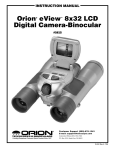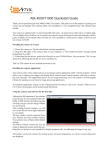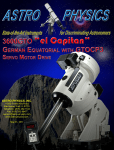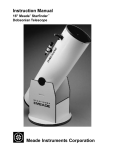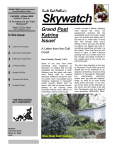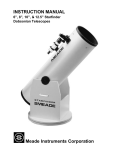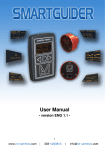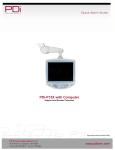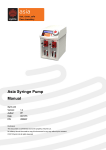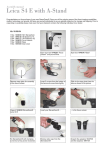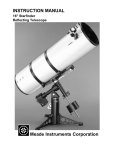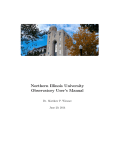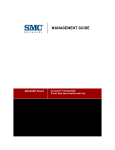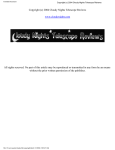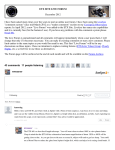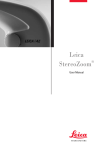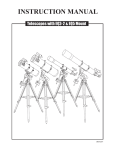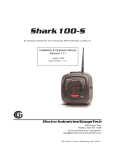Download BINOTRON-27 Owner`s Manual
Transcript
1 BINOTRON-27 Owner's Manual 2 2.Table of Contents 3. Diagram of Parts 4. Eyepiece Holder Diagram 5. CollitronTM Rings and Collimation Without a Telescope 6. Collimation Without a Telescope ctd, Collimation With a Telescope 7. Collimation With a Telescope/ Field Chart 8. Collitron Ring Tightening Tool, The Power x Switch 9. Newtonian Telescopes 10. Newtonian Telescopes ctd 11 .Refractor Telescopes 12. Refractor Telescopes ctd 13. SCT Telescopes 14. Optional Accessories: OCS-A45, Eyepieces 15. Optional Accessories: Filter Switch, Filters 16. Warranty and Contact Information 3 Diagram of Parts The BINOTRON-27 Super System has been designed to focus at three magnifications in virtually any telescope designed for typical single eyepiece use. Not only is focus achieved, but three powers are accessible using the patented Power x Switch while using only one pair of eyepieces. Becoming familiar with the various parts of the B-27 Super System will be very useful and allow smooth and trouble free operation. Obtaining focus in various telescope designs is dependent on using the B-27 Super System correctly. In the following pages, there are descriptions and pictures detailing proper usage for Newtonians, Refractors and SCTs. Importantly, become very familiar with the diagram of the B-27 Collitron Eyepiece holders on the following page. Otherwise, incorrect parts of the eyepiece holder assembly will be turned at night during use in the field and this will become frustrating. By spending time indoors in the light of your home and using the eyepiece holders correctly, misidentifying the eyepiece holder parts at night can be avoided. TM Referring to the above diagram, all parts are required when using a Newtonian Telescope. See the Newtonian Telescopes Section for specific instructions. When using a Refractor and other scopes that work similarly such as classical cassegrains, Mewlons, Planewave Telescopes, some Maksutovs, and many Ritchey Chretians, the parts labled D and E are not used. refer to the Refractor Telescopes section. In SCTs, the parts labeled D, E and F are not used so refer to the SCT section. Specific use is explained with more detail in each of the sections on Newtonians, Refractors and SCTs. So, please learn how to properly use the B-27 Super System by reading the sections on any telescope that you will be using. It is very simple, as long as the brief instructions are properly followed. 4 Eyepiece Holder Parts and Use The patent pending CollitronTM equipped eyepiece holders are a Denkmeier innovation that we are very excited about. The Binoviewer can be collimated in a minute or less and very easily using this feature. This is thoroughly explained in the page following this one. However, the Collitron Ring is not the only feature that is special about the B-27 eyepiece holder. The diopter rings on each eyepiece holder allow the user to obtain a very sharp focus for individual eyes. Therefore, those without perfect 20/20 vision can adjust focus for both the right and left eye while viewing through their B-27 Binoviewer System. In fact, these new focusing mechanism do not rotate the eyepiece. The eyepiece moves up and down in a very smooth motion. The focus adjustment has been set to an ideal speed as well. A change is easily observed, but the motion is still considered to be "micro". Loading the Eyepieces The top "Eyepiece Locking Ring" (EPLR) allows the eyepiece to be inserted smoothly by turning this uppermost ring counter-clockwise and removing the Dust Plugs. This allows an internal self centering split ring to expand. Once the eyepiece barrel is fully inserted, the Locking Ring is then turned clockwise until the eyepiece is held securely. Over tightening is not necessary but the ring should be turned to a point where it is nicely fingertightened. Focusing Individual Eyepieces Now, the diopters should be turned upward but only slightly by rotating the Diopter Ring Clockwise. If both Diopters are moved upward so that perhaps the second white gradient line below the + sign is showing, each diopter may now be used at the telescope and be moved both up and down for sharp individual focus in each eye. Each person's eyes may focus differently so the individual using the B-27 will want to take note of where the diopters are set for best focus so that this can be quickly readied for each observing session. Note: It is our opinion that focus should be monitored and adjusted as needed during a nights' observing. Rather than assuming one is in perfect focus, we have found that it is essential to check focus of each eyepiece periodically as sky conditions change and the scope is moved to different locations of the sky throughout the night. Viewing in proper and sharpest focus is too important to ignore or leave to chance. It is our recommendation that you use the focusing feature of the B-27 as often as you feel necessary! Even when viewing with single eyepieces, one should be checking focus frequently. The same holds true for viewing with the B-27 Super System. Do Not Over-Tighten The Diopter Ring It is recommended that the eyepiece barrel be fully inserted into the eyepiece holder initially with the diopter fully bottomed out (turned clockwise). However, it is not necessary nor advisable to bottom out the diopter too tightly. Over-tightening the diopter mechanism when turning counter-clockwise after it bottoms out can then make it hard to free when turning clock-wise, and the lower Collitron Ring may then also become loosened unintentionally and eyepiece holder collimation will have to be performed again. This is only somewhat inconvenient though and can be quickly taken care of by using the Collitron Rings to collimate the BINOTRON-27. You will find that this is a fast and simple process, and even enjoyable to many. (see pages 4-6) 5 Collimating The BINOTRON-27TM Collimation is Easy! Below is a Brief Explanation Followed by a Very Simple Procedure. Many Telescope users become nervous when faced with the prospect of collimating an optical instrument. However, this is required if optimum performance and aberration-free images are to be obtained. Generally speaking, telescope components such as mirrors and lenses must not be tilted or shifted from an ideal relationship to one another or aberrations in the focused and defocused image will be seen. In the case of a binoviewer, when we are referring to "collimation", we are actually dealing with alignment of the left and right eyepieces so that they form a single image when merged. An object seen in the left eyepiece field at a certain location should be seen at the same location in the right eyepiece. So we are not dealing with tilting optics or aberrations, because a poorly aligned binoviewer will generally not introduce aberrations, only a "double image". This poorly merged double vision results when the target object such as a planet or star is located in different areas in each eyepiece field. In order to move the object to the same exact area in each eyepiece field, we move the eyepiece holders, not the object! The Collitron Eyepiece Holders have been designed to shift in a 360 degree direction on a flat plane. Note that we at Denkmeier "set" the prisms first, and the fixtures hold these prisms in place permanently. The Final Collimation using the Collitron Holders can be fined-tuned so that even the highest power images are in the same location in each eyepiece field. Once this is done, the binoviewer will give extremely relaxed, two-eye views at all magnifications. Collimation will become so quick and easy, that it may be repeated as often as you feel the need. We even feel that the Collitron System makes this process enjoyable. Preforming Collimation Load your eyepieces into the holders first before loosening The Collitron Rings. See preceding page. The diagram at the right illustrates how the Collitron Ring is loosened. It should be rotated counter-clockwise to a point where the black parts above the Collitron Ring can be grasped and the entire holder may be shifted in any directions. Do not over-loosen the Collitron Ring. The goal is to loosen it only enough so that both the right and left holders can be moved in any direction in a flat plane. If the Collitron Ring is loosened to much, the eyepiece holder can tilt. The Collitron Ring must only be loosened enough so that the eyepiece holder can slide in all directions in a flat plane. You are now ready to collimate. Without a Telescope Firstly, we will offer a very simple and excellent collimation method. Our B-27 Optical Collimation Device is available as an option so that your Binotron-27 may be collimated at anytime, indoors, without a telescope. This device threads into the bottom of the Binoviewer or Power x Switch and a beautiful in-focus target can be seen in both eyepiece fields. It contains a fully coated optical lens, and a laser engraved target. A separate instruction sheet is provided. Simple and Fast Procedure 1.Load eyepieces into the binoviewer eyepiece holders by following the instructions on page 4. 2. Thread the B-27 Optical Collimation Device into the bottom of the Binoviewer Power x Switch 3. View the target by looking through the eyepieces and facing a light source. 4. Make sure the target is in sharp focus for each eye. Consult B-27 Collimator instruction sheet. 5. Loosen each Collitron Ring a bit so that the Upper sections of the eyepiece holder can be shifted. A small 6 amount of friction should be present when shifting the holder. Note: The range of motion of the holder is quite limited but a small amount of movement goes a long way in relocating an image seen in the eyepiece field. Recap: Loosen the Collitron Rings just enough so that the eyepiece holders slide ( but do not tilt) a small amount in any direction. 6. View the B-27 Collimation target while sliding one or both holders in a flat plane. You will notice that the B-27 Collimation target becomes double, and very uncomfortable to observe with two eyes, and then merges and becomes one single image that is comfortable to observe as the holders are shifted. 7. When the image becomes very comfortable to view, tighten one Collitron Ring down firmly. 8. Now, while looking through the binoviewer with both eyes, close one eye and view the target carefully with the other eye. While viewing the target, observe an area of the image carefully and now open the closed eye so that you are using both eyes. Did you notice a double image of that target area that quickly came together as a single image after a very short delay? If so, slightly shift the holder with the still-loosened Collitron ring in very small increments. Test again by repeating the one-eye blink method. You will quickly obtain an ideal holder position and there will be no delay in achieving a perfectly merged single image with both eyes. This process should take minutes or less once you become accustomed to the process. Once you have found this position, tighten down the remaining loose Collitron Ring. Check things again using the same blink method. After a few times, this process will become easy, rewarding and fun! You will have mastered BINOTRON-27 Collimation. Collimation Using a Telescope The same method outlined above can be used in a telescope. Rather than using the optional B-27 Optical Collimation device, just focus on a planet or star field in your telescope. Carry out the same procedures as described above, only the object viewed in your telescope will be your target. While collimating on astronomical objects using your telescope at night works well, it may be easier if your telescope can focus on convenient terrestrial targets in the daytime since they do not move and you are working with the holders in bright daylight. In fact, we will outline a very objective method to test collimation in daylight using a telescope below. It should be done in daytime using a fixed target. Of course, very large telescopes may not be able to find terrestrial targets to focus on. In those cases, collimate while viewing astronomical objects, or purchasing the optional B-27 Optical Collimation Device . Daytime Collimation Using a Telescope (Refractor or SCT) Setting Vertical Target Location Setting Horizontal Target Location The main goal when collimating is to achieve a very comfortable strain-free view while using both eyesin your binoviewer. If a very objective, but somewhat more time consuming method collimation is preferred, we outline the following procedure . Once the Horizontal and Vertical positions of a target become identical in both the right and left eyepieces, collimation may be considered to be of a very high order and can be objectively measured. Please refer to the diagram above. The Procedure is outlined on the next page. 7 Note: Some degree of offset in the Horizontal position is acceptable and can even increase the 3-D perception that many obsrvers report when viewing planets and star clusters! Whether such offset in the horizontal aspect becomes uncomfortable may depend on the individual and the amount of offset employed. Feel free to experiment! On the other hand, vertical positions of a target in the right and left eyepiece field must be very close if not exact, or eye strain will occur. Procedure 1. Focus on a nearby target and place that object close to the vertical edge of the eyepiece field. It should not touch the edge of the eyepiece field but be very close to the edge. Set the target in either the right or left eyepiece only. It is best to start viewing with the eyepiece where the target appears closest to the upper vertical 12 o'clock position. The other eyepiece will show the target in a lower position further down from the fields upper edge. 2. Now examine the target in one eyepiece only where the target is very close to the field edge in the vertical position. If necessary, move the telescope to place the target there, as close to the field edge but not touching. 3. Look in the other eyepiece. Is the object in the same position or further down from the field edge? 4. Adjust the eyepiece holders after loosening the Collitron Rings until the object is in an identical vertical positions in each eyepiece field in relation to the upper field edge. This can take a few minutes. 5. Check the horizontal position as well. Alternating between vertical and horizontal positions while adjusting the holder will eventually result in achieving a very high order of alignment. Yes, it takes some time and getting used to, but it is a very objective measure of the degree of collimation when both vertical and horizontal positions of a target are identical in both the right and left eyepiece fields! Setting Collitron Holders For Vertical Alignment Setting Collitron Holders For Horizontal Alignment Print This Page as a Reference to Use During Actual Collimation Procedure With Telescope In Daytime Notes: 8 Collitron Ring Tightening Tool We provide a tool that allows the user to tighten the Collitron Ring if they feel that finger pressure is not adequate. This is generally unnecessary but since the amount of "finger strength" will vary from person to person, we felt that including a tool was probably a good idea. The Collitron Ring features three holes so that at least one can easily be accessed no matter where the Collitron Ring ends up in rotation after it is finger tightened. Please do not over tighten the Collitron Ring! The ring should only be tightened to the point where it will not become loosened while operating the upper black rings used for locking and unlocking the eyepiece and adjusting individual focus (see page 3). The Power x SwitchTM The Dual Arm Power x Switch is our patented device invented by Russell Lederman of Denkmeier Optical. It functions in various ways, depending on the telescope type being used. The three magnification factors produced are different depending on the telescope. This is explained in more detail in the sections labeled Newtonian, Refractor and SCT use. The name "Power x Switch" is actually verbalized without the "x". We needed to add the "x" for trademark purposes. A fully coated optical doublet is housed in each carrier arm (two arms). So there is a low power mode, a mid power, and a high power mode. The low power lens is always housed in the lens carrier installed on the Logo-Side of the Power x Switch Body. The non-Logo side contains the highest power lens. The Mid-Power is achieved with both Power x Switch arms in the out position. Only one arm can be moved inward into the light path at a time, and should be moved in completely, until travel terminates. The illustration at lower right shows the low power arm on the Logo-Side fully inserted into the light path of the binoviewer. The magnifications that result are indicated in the photo. These magnification factors are multiples of what a single eyepiece would produce. Ex: If an eyepiece renders 100X when used as a single eyepiece, it will produce 130X when used in the B-27 Super System with the Low Power Arm moved to "IN" , when a Newtonian or Refractor is used. It will produce only 66X when used in an SCT. This is explained in more detail later in this manual. 9 Using Newtonian Telescopes Please refer to the Parts Diagram on page 2. The B-27 Super System is shipped in the case fully assembled and ready for use in Newtonian Telescopes. What you will receive is shown above. Note that the illustration also shows the B-27 with optional D21 Eyepieces. The D21 Eyepieces are not included unless you have ordered them. The Super System Assembly consisting of Power x Switch, 2" Part O Nosepiece, Middle Newtonian Spacer with Silver Lock Ring, and finally the Multi-Purpose OCS Cell must be inserted fully into your focuser until the Power X Switch is flush with your focuser drawtube. 1.Now, the Lower Power Arm is pushed in. Rack your focuser drawtube in until focus is achieved. 2. If focus is not achieved, remove the entire assembly from the telescope and thread out the Middle Newtonian Spacer and Silver Lock Ring from the 2" Part O Nosepiece. The Silver Lock Ring may be a bit tight. Unthread it counter-clockwise to allow the Middle Newtonian Spacer to be lengthened outward (unthreaded). Try to focus again by sliding the entire system back into the focuser until flush. Remember that the Low Power Mode requires the most in-travel of your focuser. The Middle Newtonian Spacer must be lengthened until you can rack inward just past focus. It is important to be able to go inward past the focus point, and then outward to a perfect focus in order to be sure that perfect focus has been achieved. Every scope is a bit different which is why the Middle Spacer's ability to be lengthened is so important. Once the Middle Newtonian Spacer has been set properly, the Silver Lock Ring can be threaded back downward until flush with the 2" Part O Nosepiece. If focus is not achieved in Low Power Mode, please see "Troubleshooting". 10 Newtonian Use (continued) Once Low power Focus has been achieved, the next is mid power. Move the Low Power Arm completely out. Now both Power x Switch arms are in the out position. This is mid power in Newtonian Telescopes. You must rack your focuser draw tube outward until focus is achieved. This is considered by many to be the ideal power mode for observing planets. Only the front OCS Lens is being used now to bring focus through the B-27 Body to your eyepieces. While all of the Power x Switch optics are of very high quality, many believe that the fewer optics there are in the light path, the better the image quality. The next power mode is the highest. This is achieved when the arm on the non-logo side of the Power x Switch is moved into the light path. This requires the most out travel. If you rack your focuser drawtube completely out and still do not achieve focus (which is possible with many low profile focusers), loosen your drawtube thumbscrew and pull the binoviewer assembly out a bit until you achieve focus and then go outward a slight amount past that point. The 2" tubes of the Super System Assembly provide an abundance of contact area allowing this to be done without any issues. Hopefully, you can still rack inward and achieve low power focus when pushing in the logo side arm. It is possible that with some telescopes, all three focus positions will not be reached without the need to withdraw the Super System Assembly outward in highest power mode. This depends on how the Newtonian mirrors, and focuser have been spaced. Trouble Shooting Images seem poor: In the unlikely event that this occurs, check collimation of the telescope. with the B-27 Super System in place. Diffraction patterns should be unchanged when using the B-27 Super System as compared to a single eyepiece. However, the scope should have the collimation fine tuned using a stellar diffraction pattern in certain cases, for optimal performance. This may be caused by focuser drop due to the weight of the B-27 Super System. In fact, many observers choose to re-check collimation when the scope is pointed at various areas of the sky! It is always a good idea to be able to examine a diffraction pattern and fine tune the Primary Mirror collimation so that the airy disc of the diffraction pattern appears at dead center as focus is closed down to a point. Do I need a counterweight? Yes, very likely. Any heavy accessory should be counter weighed. There are so many methods that one can employ and there is a wealth of information on the internet to help you decide which one is best for you. I can't reach focus in Low Power Mode no matter how far I lengthen the Middle Newtonian Spacer. Call us. We can provide a spacer cell that threads between the Newtonian spacer and the OCS Cell and this will solve the problem and allow the Newtonian Spacer to be also be closed back down a bit. Another alternative is to move your primary mirror collimation bolts higher, pushing the mirror a bit closer to the secondary mirror. A third alternative requires your truss poles to be trimmed slightly. In solid tubes, the mirror cell can be moved up. 11 Using Refractor Telescopes In order to achieve a focused image, Refractors require optical assistance when using a binoviewer. Our Power x Switch and Optical Corrector System (OCS) allow focus to be obtained. The BINOTRON-27 Super System must be used correctly for focus to be achieved. We outline the methods below. There are a few refractors that were/are specially shortened in order to allow a binoviewer to focus. These can be made to work in a different way than the typical Refractor. We will cover this special case at the end of this section. In the illustration on the right, the OCS Cell has been threaded into the end of a 2" star diagonal on the telescope side. This now allows focus to occur when the binoviewer is loaded into the eyepiece holder of the star diagonal. The Middle Newtonian Spacer is not used for refractors. Refractor Use 1. Remove the Middle Spacer with Silver Lock Ring and the OCS Cell from the 2" Part O Nosepiece. The Part O Nosepiece remains in the Power x Switch. 2. Thread the OCS Cell that has been removed from the Middle Newtonian Spacer Tube into the telescope-side tube of your 2" star diagonal. 3. Load the Binoviewer with Power x Switch and 2" Part O Nosepiece into the eyepiece holder of the star diagonal. 4. Now, push in the Low Power Arm (Logo-Side) of the Power x Switch. In order to reach focus, the drawtube of the refractor must be racked inward. The magnification factor is approximately 1.3X. In other words, if a single eyepiece produces 30X when used in mono-mode, it will now produce 39X in the binoviewer or 1.3x30x=39x. These figures are approximate and can vary slightly. 5. After obtaining focus, move the Low Power Arm out. With both arms of the Power x Switch in the out position, mid power results with approximately a 2.3X magnification factor. Again using the above example, 69X will be the result. Various brands of Diagonals may affect these magnification factors slightly. 6. Now, the final highest power magnification of the Power x Switch can be implemented by moving the NonLogo Side Power x Switch arm inward. The focuser of the refractor must be racked outward to reach focus. The magnification factor becomes 3X or again, using the above example results in 90X. Note: many Refractors have only a small amount of overall draw tube travel. Those scopes with less than 3.5" of overall travel may fail to reach focus in the highest power mode. This issue can be eliminated by withdrawing the star diagonal from the telescope until focus is reached. Use of a short 2" extension tube is also a very good remedy. Denkmeier or William Optics Diagonals When using our Denkmeier Optical Diagonal or a William Optics Diagonal, the position of the OCS Cell can be placed closer to the diagonal mirror. In the illustration on the right, the 2" diagonal tube has been removed and the OCS Cell has been threaded directly into the diagonal body. Then the removed 2" diagonal tube has been threaded into the OCS Cell female threads. All threads are 48mm male or female. By placing the OCS cell directly onto the diagonal body, two things are accomplished - The focus position is brought more inward toward the telescope, and the magnification is slightly lowered in all Power x Switch settings. 12 Trouble Shooting Scope is Unstable Due to Weight As with all heavy accessories, adding the B-27 to your Refractor requires careful counter-weighing. Images Seem Dim Most refractors have relatively small aperture. Images will be dim especially at 3X if high power eyepieces are used. Of course this depends on the intrinsic brightness of the object being viewed. While deepsky objects can be viewed satisfactorily, this depends on sky darkness, brightness of the target, and the focal length of the eyepieces being used. Refractors excel on planetary and lunar viewing with a binoviewer unless the observing site is a dark one. Expectations should be realistic when using a small aperture telescope. High Power 3X Mode Will Not Focus The Mid and High Power Modes of the Power x Switch require the focuser of the Refractor to be racked outward. Many refractors have only a limited overall length of the focuser tube. If the focuser drawtube has less than 3.5" of overall travel, it is possible that the highest and even the mid power settings will fail to reach focus when the tube of the refractor is fully racked out. Two Inch Extension Tubes are widely available and some cost under $20. It is a good idea to obtain one. Another quick remedy is to just pull the star diagonal out of the drawtube until focus is reached, and then lock the diagonal in with the drawtube thumb screw. Be careful! You must use good judgment when ascertaining whether this solution is the proper way for you. Note that refractors vary widely and the focal plane position in relation to the focuser varies as well. Do not withdraw the B-27 from the diagonal eyepiece holder as this is not a good solution and will likely not allow focus to be achieved. Special Shortened Refractors Some refractors have been made with removable extensions so that a binoviewer will focus without the need for optical lenses. If the BINOTRON-27 Super System is to be used with the Power xSwitch and OCS then follow the Refractor Instructions and make sure that the removable extension tubes are installed in your refractor so that it operates like a conventional scope. Then the B-27 will operate properly. If the extensions are removed from your scope, then the BINOTRON-27 may reach focus without the OCS installed in the diagonal. A third method is to thread the OCS directly into the 2" Part O Nosepiece. Then the Power x Switch will function. The refractor must still be shortened (no extension tubes) but this may require more outward racking than is available unless a mid range extension tube has been provided. If not, purchase a 2" extension tube with about 2" - 3"of length. If necessary, the extension can be slid in or out of the telescope to hit all focus positions. Terrestrial Viewing-Because many objects are close to the observer, focus is pushed outward . A long extension tube should be placed in the telescope before the star diagonal so that the diagonal and B-27 Super System can slide outward as needed. Rule: Close Targets require more outward sliding of the star diagonal. 13 SCT TELECOPES Schmidt Cassegrain Telescopes are very versatile and the BINOTRON-27 Super System works in a very different way. The typical SCT has a moving primary mirror. As it is moved toward the secondary mirror mounted on the front corrector plate, focus is pushed out of the rear of the optical tube. This provides a great amount of "back focus". Therefore, the OCS cell is not used, or required. In fact, the focus is moved so far outward, that the Power x Switch can produce true focal reduction when the Low Power Arm is pushed in. This is very important because the typical F/10 ratio of an 8", 9.25", 10" or larger SCT produces a very large image scale. The ability to implement focal reduction changes this F/10 to approximately an F/6.6 ratio. This makes deepsky objects more compact due to lower power. The object becomes easier to see. The Mid Power setting increases the focal ratio a bit. The Power Factor is about 1.15X and this is due to the interaction of the primary mirror with the telenegative secondary mirror. The highest power mode becomes approximately 2X since no OCS Cell is being used. SCT Use 1. Remove the Middle Newtonian Spacer with Silver Lock Ring and the OCS Cell. These are not used in an SCT. The illustration at right shows the BIONTRON-27 ready to be used in an SCT. 2. Load the unit into your 2" Star Diagonal. Note: An optional 1.25" nosepiece is available for 1.25" diagonal use, though use of a 2" diagonal is more stable and recommended. 3. Start with both Power x Switch Arms in the OUT position as pictured at right. This is the mid power mode. Point the scope to a bright object to start. 4. The focuser knob of your SCT Scope must be turned counter-clockwise until focus is achieved. It will likely require many turns and this will vary from scope to scope. 5. Once focus in Mid Power Position is reached, move the Logo-Side Low Power Arm inward. This is the Focal Reduction Mode and produces approximately F/6.6. In other words, if a single eyepiece produces 50X, this reduction mode will produce 33X. Several turns of the focuser from the Mid Power Position in a counterclockwise rotation will be required to reach focus. 6. It is always advised that when leaving the Reduction Mode, move the Reduction Arm out and once again focus in Mid Power Mode. This requires several clockwise turns of the focuser knob of your SCT. One focus is achieved in Mid Power, move the Non-Logo-Side Arm in. This is High Power Mode and produces a 2X factor. A 50X power eyepiece used singly, will operate at 100X. in the B-27. The focuser knob must be rotating Clockwise from the point where mid-power focus was. Trouble Shooting I cannot reach focus in Reduction Mode. Most SCTs reach focus. If you run out of counter-clockwise turns when trying to focus in reduction mode, we can provide solutions. We are currently designing a special SCT right angle prism diagonal that has the shortest possible light path and will reduce the back focus requirements so that focus in reduction mode will not be a problem. It will be available soon. We also have other solutions available at this time. Call for more information. Images are not as sharp as hoped All SCT Owners should become very familiar with collimating the secondary mirror of their telescope. This is a must of the best optical images are to be obtained with both single eyepieces as well as the BINOTRON-27. It is recommended that one collimate the secondary mirror with the BINOTRON-27. A star can be centered and viewed with both eyes, and the secondary mirror can be collimated in the same way as when using a single eyepiece. The views will be very sharp if care is taken to do this. 14 Optional Accessories OCS-A45 The OCS Cell shipped with all BINOTRON-27 Super Systems has a clear aperture of 37mm. Pictured at right is the new OCS-A45. This optic has a clear aperture of 45mm, the largest we could make in a 2" format. It can better handle the outer rays of a converging beam produced by a telescope mirror and this means better illumination. We recommend it for any telescope faster than F/5 and we also believe that the benefit of using this may be observable in slower telescopes. Super Optical Quality, Fully Multi-Coated of course! Each lens is tested in our NY Facilty before being passed. Denkmeier Eyepieces Our Denkmeier Eyepieces are world renowned and for good reason - The glass used is high index, the coatings are the best, and the performance is exquisite. No, the D21s and D14s are not inexpensive. But remember that any pair of eyepieces used in the BINOTRON-27 Super System becomes three pairs! This is because they operate at three magnifications. When given the choice of using an average eyepiece pair, or a fantastic pair, consider that the pair used essentially triples in operation. Available in 21mm and 14mm focal length, they sport 65 degrees of AFOV and provide amazing performance on planets, The Moon, and deepsky objects. Our D21s and D14s are as light as we can possibly make them. The barrels are anodized aluminum, not chrome plated brass in order to reduce weight. Consider adding a pair of our D21s, D14s, or both to your BINOTRON-27 Eyepiece Specifications Weight D21 8oz D14 9oz Eye Relief 20mm AFOV 65 Degrees Color Corrected: Yes High Index Glass: Yes All Lenses Fully Multi-Coated: Yes Matched and Tested: Yes Rotating Batwing Eyeguards: Yes D21: 6 Elements, 4 Groups D14: 6 Elements, 5 Groups D21 Eyepieces in BINOTRON-27 Equipped With Optional Filter Switch 15 The Filter Switch Using filters in your telescope can greatly enhance the visibility of many deepsky objects. Being able to move filters in and out of the light path quickly is a great thing! That is precisely what our Denkmeier Filter Switch allows you to do. So, why not add our Filter Switch System to your BIONTRON-27 Super System. In addition to changing magnifications with the Super System Power x Switch, you can also move filters in and out of the view at will, without ever having to pull your two eyes away from your BINOTRON-27. At Denkmeier Optical, we pride ourselves on the quality of our machining. The Filter Slides move in out of the light path with a buttery smooth feel. There are three possible Filter Switch positions; No Filter, Right Filter, and Left Filter. You can easily slip each carrier loaded with a filter out of the Filter Switch Body without tools, then load other filters in seconds. It is suggested that you equip every filter that you own with a carrier so it is ready to be loaded into the Filter Switch Module. We even make 1.25" Step Down carriers that will carry our optional planetary filter or most other 1.25" filters. While the Filter Switch can be added later, it is best to add this option at the time that you purchase your BINOTRON-27 Super System to avoid extra cost. The Filter Switch option is reasonably priced, and a great addition! Our carriers accept virtually all brands of filters though we do recommend that you consider our Denk Hi-Def Filters if you do not already own filters. Denk Hi-Def Filters Did you know that we make our own filters? Using our on-site Ion Beam Sputtering Technology (IBS) , we produce our own brand of world class Nebula and Planetary filters. Our OIII Filter performs exceptionally on emission Nebulae, Planetary Nebulae, and many super Nova remnants like The Veil Nebula, and is available in 1.25" or 2" format. With a wider bandpass than the OIII, our UHC Filter allows the H-b line to transmit and performs better on some deepsky objects than the OIII. One of the above does not make the other obsolete though. We do suggest reading up on filter use. There is a lot of information out there that is useful to know and some objects are seen better with the OIII while others better lend themselves to UHC use. Our Dual Band Planetary Filter will bring out features on planet discs that may otherwise be difficult to observe. Please visit our website and read about our filters. They make an excellent addition to the Filter Switch Option if you do not already own filters. 16 Warranty Information We will fix or replace your BINOTRON-27 Super System or any additional optional accessory purchased from Denkmeier Optical, Inc. or an authorized Denkmeier Dealer for a period of one year after delivery. This warranty covers any failure of the system or optics due to faulty manufacturing or damage incurred during normal use due to parts failure. While we are always willing to repair systems due to accidental dropping or other circumstances beyond our control, this type of damage is not covered under the warranty. Shipping charges may also apply. This warranty does not cover any product that was purchased second hand whether through a dealer or a private party. This warranty covers the original purchaser only. It is strongly recommended that you retain your original receipt as a record of purchase. Contact Information We can be reached toll-free at 866-340-4578. This may not work outside of the USA. We can also be reached by dialing 410-208-6014. If dialing from outside of the USA, our country code is 01. Email us at [email protected] Denkmeier Optical Headquarters are located in Hauppauge, NY. Our Shipping Address: Denkmeier/Spectrum Thin Films 135 Marcus Blvd Hauppauge, NY 11788 Denkmeier Optical Workers SpectrumThin Films Coating Lab Area Tony Pirera, Ted Haucher and Russ Lederman at NEAF, 2012 Denkmeier Optical, Inc. Headquarters are located in Hauppauge, NY. We joined forces with Spectrum Thin Films 4 years ago, making the move to their headquarters on Long Island in New York. Originally, Spectrum Thin Films coated our optics before we decided to team up. Denkmeier Optical, Inc. is co-owned by Anthony Pirera and Denkmeier Optical Founder Russ Lederman, inventor of the Optical Corrector System, Power x Switch, and Power Switch Star Diagonals. Our workers are experienced in handling optics of all kinds under clean room conditions. Various types of optical coatings are done on premises for professional observatories, NASA, and other clients. The benefit of teaming up with Spectrum Thin Films has enabled Denkmeier Optical to innovate and bring new products to the marketplace. The future looks very bright. Keep looking for new products in the next few years! Copyright, 2013 Denkmeier Optical, Inc. All rights reserved. Reproduction without written permission from Denkmeier Optical, Inc. is Prohibited.
















